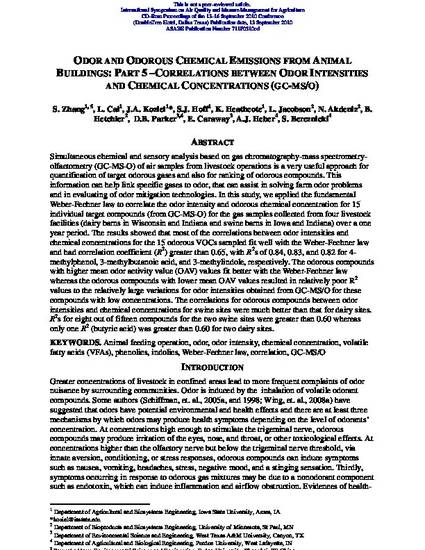
Simultaneous chemical and sensory analysis based on gas chromatography-mass spectrometry-olfactometry (GC-MS-O) of air samples from livestock operations is a very useful approach for quantification of target odorous gases and also for ranking of odorous compounds. This information can help link specific gases to odor, that can assist in solving farm odor problems and in evaluating of odor mitigation technologies. In this study, we applied the fundamental Weber-Fechner law to correlate the odor intensity and odorous chemical concentration for 15 individual target compounds (from GC-MS-O) for the gas samples collected from four livestock facilities (dairy barns in Wisconsin and Indiana and swine barns in Iowa and Indiana) over a one year period. The results showed that most of the correlations between odor intensities and chemical concentrations for the 15 odorous VOCs sampled fit well with the Weber-Fechner law and had correlation coefficient (R2) greater than 0.65, with R2s of 0.84, 0.83, and 0.82 for 4-methylphenol, 3-methylbutanoic acid, and 3-methylindole, respectively. The odorous compounds with higher mean odor activity value (OAV) values fit better with the Weber-Fechner law whereas the odorous compounds with lower mean OAV values resulted in relatively poor R2 values to the relatively large variations for odor intensities obtained from GC-MS/O for these compounds with low concentrations. The correlations for odorous compounds between odor intensities and chemical concentrations for swine sites were much better than that for dairy sites. R2s for eight out of fifteen compounds for the two swine sites were greater than 0.60 whereas only one R2 (butyric acid) was greater than 0.60 for two dairy sites.
Available at: http://works.bepress.com/steven_hoff/91/

This proceeding is from International Symposium on Air Quality & Manure Management for Agriculture CD-Rom Proceedings (13–16 September 2010, Double Tree Hotel, Dallas Texas) St. Joseph, Michigan: ASABE, 13 September 2010. ASAE Pub #711P0510cd.